Operator Dolphin Drilling Laid down 31 October 1972 Construction started 31 October 1972 | Yard number Aker Verdal A/S (695) Length 108 m Builder Aker ASA | |
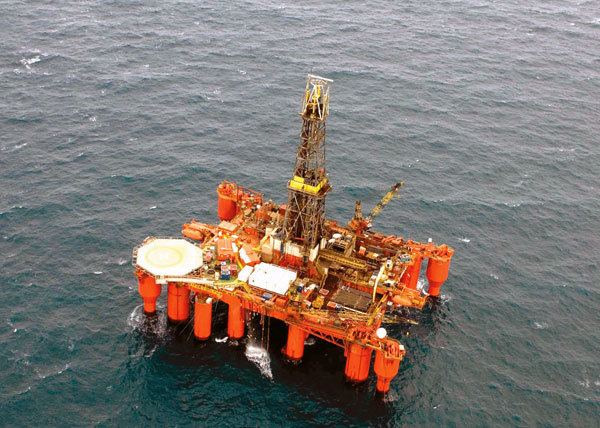 | ||
Name Byford DolphinDeep Sea Driller (1974–1978) Owner Byford Dolphin Pte. Ltd. (Fred. Olsen Energy) Similar Aban Pearl, Songa Mercur, Castoro Sei | ||
Byford Dolphin is a semi-submersible, column-stabilised drilling rig operated by Dolphin Drilling, a Fred. Olsen Energy subsidiary, and currently contracted by BP for drilling in the United Kingdom section of the North Sea. It is registered in Hamilton, Bermuda. The rig has suffered some serious accidents, most notably an explosive decompression in 1983 that killed four divers and one dive tender, and badly injured another dive tender.
Contents
- The Most Gruesome Death Imaginable The Byford Dolphin Accident
- Description
- Deep Sea Driller accident
- Diving bell accident
- Medical findings
- Investigation
- Post investigation
- Subsequent lawsuit
- Other incidents
- References
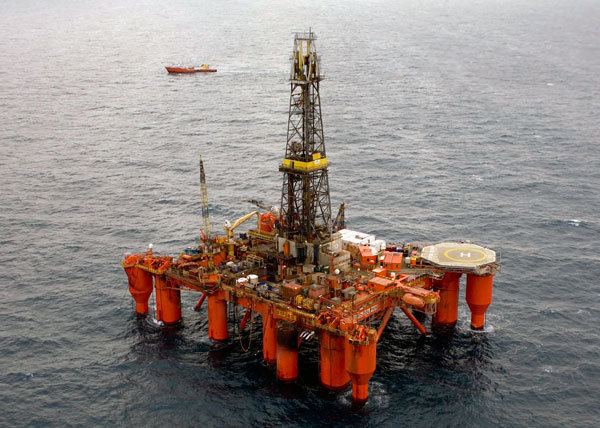
In 2009, it was contracted for three years to BP.
The Most Gruesome Death Imaginable: The Byford Dolphin Accident
Description
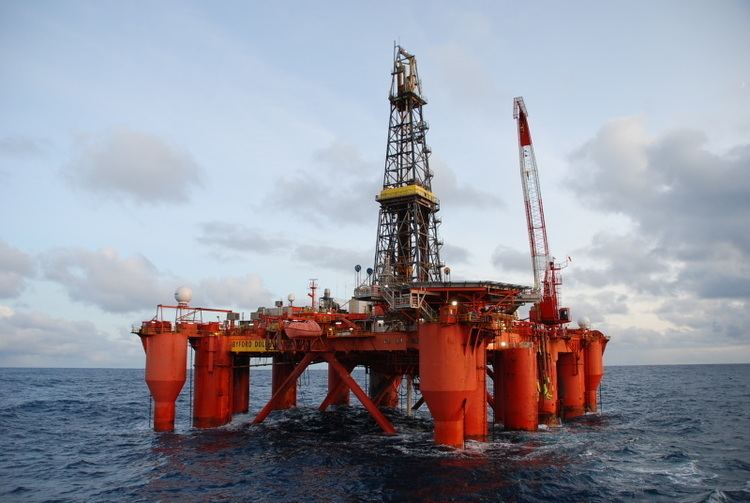
Byford Dolphin drilling rig is an Enhanced Aker H-3 design which was built by Aker Group at the Aker Verdal shipyard in 1974. Between 1974 and 1978, she was named Deep Sea Driller.

Byford Dolphin has a length of 108.2 metres (355 ft), breadth of 67.4 metres (221 ft) and depth of 36.6 metres (120 ft). It has a maximum drilling depth of 6,100 metres (20,000 ft), and it could operate at a water depth of 460 metres (1,500 ft). As a drilling rig, Byford Dolphin is equipped with advanced drilling equipment and has to meet strict levels of certification under Norwegian law. Byford Dolphin is able to maneuver with its own engines (to counter drift and ocean currents), but for long-distance relocation, it must be moved by specialist tugboats.
Deep Sea Driller accident
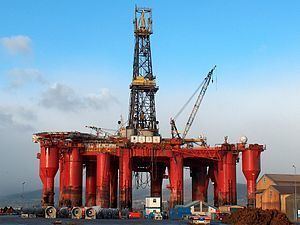
On 1 March 1976, the rig ran aground during transit from a block in the North Sea to Bergen. All crew were evacuated in the life boats, but six people died when they fell from the life boat.
Diving bell accident
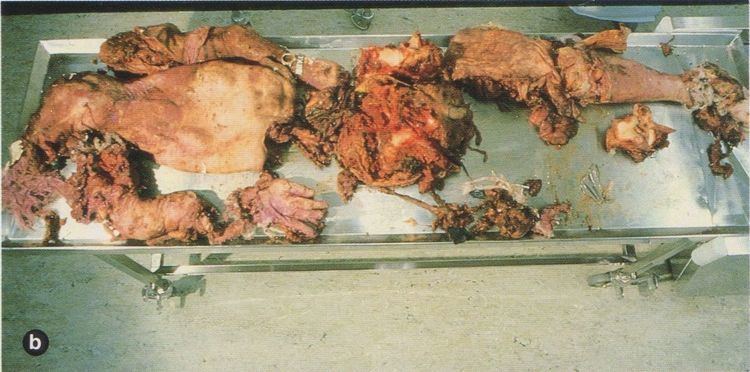
On 5 November 1983 at 4:00 a.m., while drilling in the Frigg gas field in the Norwegian sector of the North Sea, four divers were in a decompression chamber system attached by a trunk (a short passage) to a diving bell on the rig, being assisted by two dive tenders. The four divers were:

Hellevik was about to close the door between the chamber system and the trunk when the chamber explosively decompressed from a pressure of nine atmospheres to one atmosphere in a fraction of a second. One of the tenders, 32-year-old William Crammond of Great Britain, and all four of the divers were killed instantly; the other tender, Saunders, was severely injured.
The situation just before this accident was as follows: Decompression chambers 1 and 2 were connected via a trunk to a diving bell. This connection was sealed by a clamp operated by two tenders, who were themselves experienced divers. A third chamber was connected to this system but was not involved. On this day, Coward and Lucas were resting in chamber 2 at a pressure of 9 atm. The diving bell with Bergersen and Hellevik had just been winched up after a dive and joined to the trunk. Leaving their wet gear in the trunk, the divers then climbed through the trunk into chamber 1.
The normal procedure would have been
- Close the bell door.
- The diving supervisor would then slightly increase the bell pressure to seal this door tightly.
- Close the door between the trunk and chamber 1.
- Slowly depressurize the trunk to 1 atmosphere.
- Open the clamp to separate the bell from the chamber system.
The first two steps had been completed when, for an unknown reason, one of the tenders (Crammond) opened the clamp before Diver 4 (Hellevik) could close the door to the chamber. This resulted in the explosive decompression of the unsealed chamber. Air rushed out of the chamber with tremendous force, jamming the interior trunk door and pushing the bell away, striking the two tenders. The tender who opened the clamp was killed while the other was severely injured.
Coward, Lucas, and Bergersen were exposed to the effects of explosive decompression and died in the positions indicated by the diagram. Subsequent investigation by forensic pathologists determined Hellevik, being exposed to the highest pressure gradient and in the process of moving to secure the inner door, was forced through the 60 centimetres (24 in) in diameter opening created by the jammed interior trunk door by escaping air and violently dismembered, including bisection of the thoracoabdominal cavity which further resulted in expulsion of all internal organs of the chest and abdomen except the trachea and a section of small intestine and of the thoracic spine and projecting them some distance, one section later being found 10 metres (30 ft) vertically above the exterior pressure door.
Medical findings
Medical investigations were carried out on the four divers' remains. The most conspicuous finding of the autopsy was large amounts of fat in large arteries and veins and in the cardiac chambers, as well as intravascular fat in organs, especially the liver. This fat was unlikely to be embolic, but must have precipitated from the blood in situ. It is suggested the boiling of the blood denatured the lipoprotein complexes, rendering the lipids insoluble.
The rigor mortis was unusually strong. The hypostases (accumulations of blood in internal organs) were light red, and in two cases, there were numerous hemorrhages in the livers. All the organs showed large amounts of gas in the blood vessels, and scattered hemorrhages were found in soft tissues. One of the divers had a large sub-conjunctival bulla (a blister in the tissue of the eye).
Investigation
The committee investigating the accident concluded that it was caused by human error on the part of the dive tender who opened the clamp. It is not clear whether the tender who opened the clamp before the trunk was depressurized did so by order of his supervisor, on his own initiative, or because of miscommunication. At the time, the only communication the tenders on the outside of the chamber system had was through a bullhorn attached to the wall surface; with heavy noise from the rig and sea, it was hard to listen in on what was going on. Fatigue from many hard hours of work also took its toll among the divers, who often worked 16-hour shifts. Modifications to the "planned use of overtime" policies were made as a result of further investigation into this incident.
This incident was also attributed to engineering failure. The obsolete Byford Dolphin diving system, dating from 1975, was not equipped with fail-safe hatches, outboard pressure gauges, and an interlocking mechanism, which would have prevented the trunk from being opened while the system was under pressure. Prior to the accident, Norske Veritas had issued the following rule for certification: "Connecting mechanisms between bell and chambers are to be so arranged that they cannot be operated when the trunk is pressurized," therefore requiring such systems to have fail-safe seals and interlocking mechanisms. One month after the accident, Norske Veritas and the Norwegian oil directorate made the rule final for all bell systems.
Among others, former crew members of Byford Dolphin and NOPEF (a Norwegian oil and petro-chemical union) have come forward and claimed the investigation was a cover-up. They claimed that the commission investigating the accident did not mention in their report the irresponsible dispensations on vital equipment requested by Comex and authorized by the diving section to the Norwegian Petroleum Directorate, which played a vital role in the accident's occurrence. They also alleged the accident was due to a lack of proper equipment, including clamping mechanisms equipped with interlocking mechanisms (which would be impossible to open while the chamber system was still under pressure), outboard pressure gauges, and a safe communication system, all of which had been held back because of dispensations by the Norwegian Petroleum Directorate.
Post-investigation
The conclusions of the investigation were disputed, and a group of divers gathered evidence with the intention of "find[ing] justice for all of the crew of Byford Dolphin." The group formed the North Sea Divers Alliance in the early 1990s and now campaigns for compensation for divers killed or injured in the Norwegian Sector of the North Sea.
Subsequent lawsuit
The North Sea Divers Alliance, established by pioneering North Sea divers and family members of those who lost their lives, persisted in their quest for a deeper inquiry. In February 2008, they secured a report suggesting that defective equipment was the actual cause of the incidents. Clare Lucas, Roy Lucas's daughter, remarked, "I would go so far as to say that the Norwegian Government murdered my father because they knew that they were diving with an unsafe decompression chamber." After 26 years since the tragic events, the divers' families were ultimately awarded compensation by the Norwegian government.
